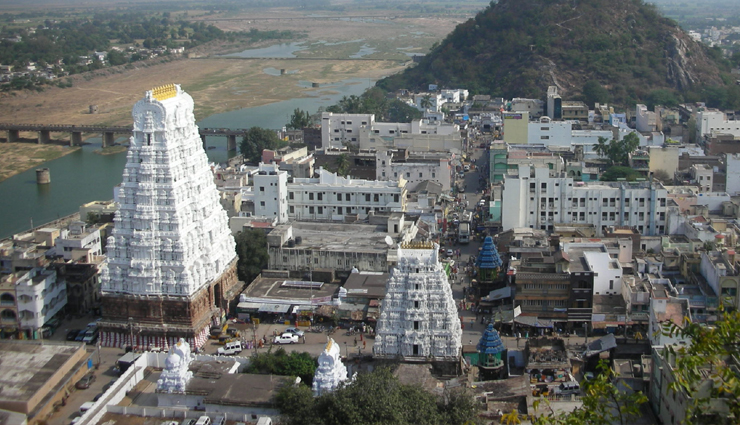Facts You Must Know About Srikalahasti Temple, Andhra Pradesh
By: Priyanka Maheshwari Tue, 25 July 2023 11:14:01

Srikalahasti Temple, also known as SriKalahasteeswara Temple, stands among the renowned Lord Shiva temples situated in the Chittoor district of Andhra Pradesh's Rayalaseema region.
It holds the distinction of being one of the Panchabhoota Sthalams, representing the element of wind. Moreover, it is revered as the Rahu-Ketu Kshetra and Dakshina Kailasam.
The temple is encircled by three hills: Durgambika to the north, Kannappar to the south, and Kumaraswamy to the east. Serenely positioned along the banks of the Swarnamukhi River, it serves as a popular pilgrimage destination.
The name "Srikalahasti Temple" finds its roots in an intriguing mythological tale. According to the legend, a spider (Sri), a snake (Kala), and an elephant (Hasti) worshipped Lord Shiva in this very town, seeking Moksha.

# History of Srikalahasti Temple
As per Hindu legend, Brahma reverently worshipped Kalahatiswara at this sacred site throughout all four of the Yugas. It is believed that Arjuna, the Pandava prince from the epic Mahabharata, also offered his prayers to the presiding deity while being seated here.
The renowned Srikalahasti Temple is closely associated with the tale of Kannappa, the hunter who unintentionally became an ardent devotee of Shiva. Additionally, the temple finds mention in the canonical works of Tirumura, authored by Nakkeerar, and the Nalvars, namely Appar, Sundarar, Sambandar, and Manickavasanagar.
Another captivating legend involves Goddess Parvati, who was cursed by Lord Shiva to forsake her heavenly form and take on a human avatar. Parvati sought penance at this very location to rid herself of the curse. Consequently, Lord Shiva reconstructed her divine form using powerful mantras like the Panchakshari, leading her to be revered as Gnana Prasunamba or Gnana Prasunambika Devi.

Furthermore, a ghost named Ghanakala, afflicted by a curse, fervently prayed at the temple for 15 years. Upon chanting the Bhairava Mantra repeatedly, Lord Shiva restored the ghost's original form. The deity also tested the devotion of Thinnadu before the assembled sages at Srikalahasti by causing a tremor that brought down the roof's top.
The Srikalahasti Temple holds the distinguished status of being classified as a Paandal Petra Sthalam, revered and honored in Tevaram, one of the Saiva canons that mention two hundred and seventy-five temples.
A unique feature of this ancient temple is the white-colored Lingam, which is of great significance. So revered is this Lingam that even the priest does not touch it. This sacred site is often referred to as the Kailash of the South or Dakshin Kailash.
Dedicated to Lord Shiva and Parvati, the Srikalahasti Temple comprises two major shrines. Additionally, there is a smaller shrine for Dakshinamurthy, the Guru of Lord Shiva. Among other deities, you can find representations of Venkateswara, Vinayaka, Nataraja, Surya, and replicas of Lingas from famous Shiva temples across India.
The construction of the Srikalahasti Temple began during the 5th century under the Pallava dynasty. Over time, the Chola and Vijayanagara kings contributed significantly to its development. The main shrine underwent renovations and construction during the 10th century under the patronage of the Chola kings.

# Archietecture of Srikalahasti Temple
The Srikalahasti Temple exemplifies the exquisite Dravidian architectural style and dates back to the Pallava period in the 5th Century. Situated at the foot of a hill, some even consider it a monolithic structure. This grand temple complex boasts a south-facing entrance, while the main shrine faces west. Inside the shrine, the white stone Shiva Lingam takes on the form of an elephant's trunk, and the main gopuram towers to an impressive height of around 120 feet.
Within the temple complex, there is a mandap adorned with 100 intricately carved pillars, a splendid addition made during the reign of the Vijayanagara King, Krishnadevraya, in 1516. Furthermore, the shrine of Lord Ganesh stands tall as a 9 feet rock-cut sanctuary.
The temple is also home to various other shrines, including those for Jnanaprasanammba, Kasi Viswanatha, Suryanarayan, Subramanya, Annapurna, and Sadyoganapathi. These shrines are adorned with images of Ganapati, Mahalakshmi Ganapathi, Vallabha Ganapati, and Sahasra Lingeswara. Additionally, the temple area features two more mandaps, the Sadyogi Mandap and the Jalkoti Mandap, along with two water bodies called Chandra Pushkarani and Surya Pushkarani.
# Astonishing Facts About Srikalahasti Temple
- Srikalahasti Temple is the only temple which remains open irrespective of the Solar or Lunar eclipses.
- The significance of the temple is that the Linga is white in colour and even the priest does not touch it.
- It is also a belief that Rahu and Ketu, two of the nine planets in Indian Astrology offered their prayers at this famous temple.





